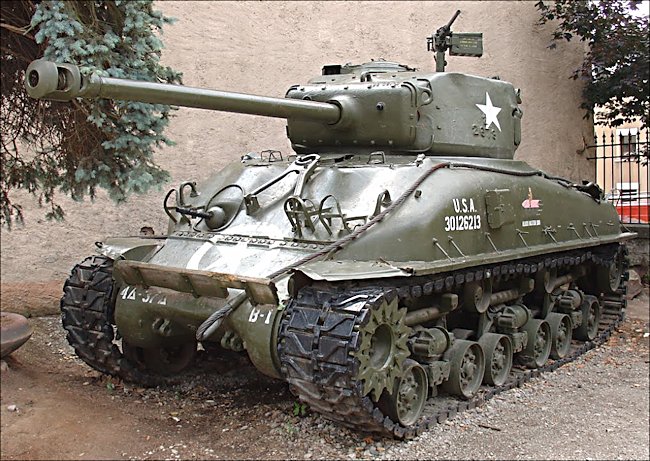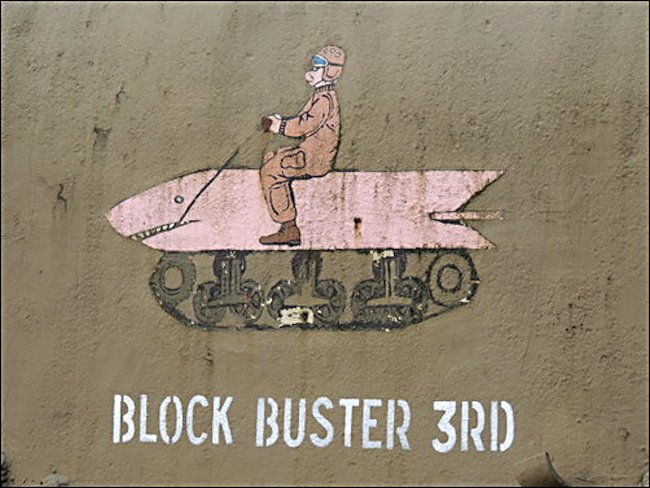Diekirch M4A1(76)W HVSS Sherman Tank
This Surviving M4A1(76)W HVSS Sherman Tank with a 76mm gun has been restored and can be seen in the grounds of the Musee National d'Histoire Militaire, in Diekirch, Luxembourg. Sherman Tank M4A1E8s didn't reach Europe until the very, very end of the war. None would have seen action during the Battle of the Bugle.

Battle of the Bulge 1944 M4A1(76)W HVSS Sherman Tank in the grounds of the Musee National d'Histoire Militaire, in Diekirch, Luxembourg
Location
One of the newest Battle of the Bulge museums can be found at 10, Bamertal, Diekirch, Luxembourg. It was opened in late 1984 in what was the former local brewery that stopped making beer in 1970. It is located right in the centre of the town.
Musee National d'Histoire Militaire, Diekirch
The generous proportions of the buildings have been used to stage several life-size dioramas. They depict different aspects of the German offensive in December 1944. Over 150 uniforms are on display complete with associated equipment, which ranges from mortar shells, minds, mine detectors, radio sets, ammunition boxes and a variety of weapons.
The museum also has a preserved German 75 mm Pak 40 anti-tank gun used during the Battle of the Bulge and abandoned near the town. As well as the M4A1(76)W HVSS Sherman tank on display outside the museum, they have a German Jagdpanzer 38(t) Hetzer tank destroyer on display. The Germans used this very effective weapon during the Battle of the Bulge that this particular example was purchased from the Swiss Army after the war.

The M4A1(76)W HVSS Sherman Tank's 76mm gun has its limits.
On Christmas Eve, 1944 American troops in the village of Manhay in the Belgium Ardennes were under a night attack by Panzergrenaders and tanks belonging to the 2nd SS Panzerkorps. They had been caught by surprise when the Germans had overrun their roadblocks. There were now in the town heading for the bridge.
Many of the American troops were in full retreat. American Captain Maxwell of the 7th Armoured Division, sent five of his light tanks to Grandmenil, a mile to the West to form a rearguard. Lieutenant Colonel Walter Richardson gave orders to blow the bridge to stop the Germans getting their tanks over the river.
The Lieutenant in charge of the demolition engineers reported over the radio, 'I've been hit. All my men are dead'. By the light of German flares that were now floating down around the bridge, Richardson saw crouched infantrymen, obviously German, running across the bridge. Then, to his horror, he saw what he reported as a 'low-slung Tiger' suddenly swing onto the highway and sneak into the long line of retreating American vehicles. He then saw a second big tank marked with crosses join the American column. These were Panther tanks.
Richardson waved passing retreating Americans pointing at the German tanks near the bridge. No one paid any attention to him. On the hill leading North. He saw the two Panther tanks suddenly swing slightly out of line and then began raking the crowded column of retreating American tanks and vehicles with their machine guns and main cannon. Confusion became panic as the American vehicles broke across the fields of the safety.
In 15 min the village of Manhay was momentarily deserted except for Richardson and Maxwell. They found four abandoned Sherman tanks. Richardson spotted a platoon of German tanks creeping up the road in the dark towards them. They climbed in to one of the Shermans. Both men believed they were advancing Tiger tanks. In their books one Tiger equaled at least four Shermans.
Capt Maxwell trained the Sherman's 76 mm gun on the leading German tank. Lieutenant Colonel Walter Richardson fired, although he believed a Tiger was usually only vulnerable between the wheels, ammo rack or the engine compartments. In fact, a high velocity shell fired from a Sherman's 76 mm gun at close range (500m) could penetrate the vertical 100 mm front armour of the Tiger tank. Unfortunately for these two American officers their target was Panther tank. Its front sloping armour gave it the equivalent of 140mm armoured protection. The round bounced harmlessly off the front of the oncoming Panther tank.
The Panther tank stopped. Its turret moved around looking through the dark for its attacker. Richardson loaded the 76 mm gun again, but it jammed. The German tank crews fired flares to lite up the crossroads. The four abandoned Sherman tanks were spotted. Both Richardson and Maxwell managed to scramble out of their tank before it exploded.
WW2 tank books

